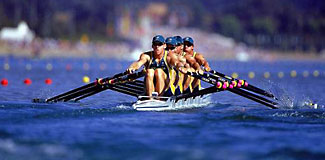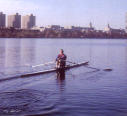Rowing

Description
In Olympic rowing, fourteen different boat classes are raced. There are eight sculling events in which two oars are used with one in each hand. There are also six sweep-oared events in which the rower uses one oar with both hands. The sculling boat classes include the single, the double and the quadruple sculls with crews of one, two or four athletes respectively, as well as the lightweight double. The sweep row categories include the pair, the four, the lightweight four,which is for men only, and the eight with coxswain. The average weight of a men's crew can't exceed 70 kg for the lightweight events (the lightweight women's double and the lightweight men's double and four). The average weight of a crew of women can't exceed 57 kg. All the races cover a distance of 2,000 metres.
The men's Olympic Rowing events are: single sculls, double sculls, lightweight double sculls, quadruple sculls, pair, four, lightweight four and eight with coxswain. The women's Olympic events are: single sculls, double sculls, lightweight double sculls, quadruple sculls, pair and eight with coxswain.
There are two categories of athletes in rowing:
- Open:(open to all athletes, regardless of their weight)
- Lightweight: Men in this category must not weigh more than 72.5 kg and women cannot exceed 59 kg. The average weight of the crew must not exceed 70 and 57 kg respectively.
There are four age group categories of athletes:
- Youth-Men and women up to 18 years old.
- Men's and women's B who are 19 to 22 years old.
- Men's and women's A who are over 23 years old.
- Veterans who are over 27 years old, provided that they no longer compete in the men's or women's A category.
History
In 1716, rowing first appeared as a competition sport in England. Rowing events for men were first held in the 1900 Olympic Games in Paris, while women's events were first held in the Olympic Games in Montreal in 1976.
Equipment
Although traditional rowing boats were made of wood, the majority of modern rowing boats are made of plastic or fiberglass. Their width is from 59.7 to 62.2 cm and their length is from a minimum of 8.2 m (for the single sculls category) to a maximum of 19.9 m (for the eight with coxswain boats). Their weight ranges from 14 to 96 kg respectively and the oars have an average length of 2.98 m in the sculls category and 3.82 m for sweep rowing.
Information taken from: http://www.athens2004.com/


Back to Summer Olympics Index
Information on basketball



